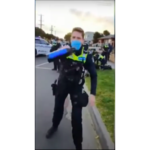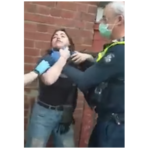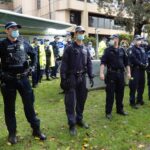Police Arrest Pregnant Woman Over Social Media Post

Welcome to the state of Victoria, September 2020, where police officers walk into a 28-year old, pregnant woman’s home, handcuff and arrest her in front of her child while she is wearing pyjamas and seize her computers and mobile phones because of something she posted to social media.
The offending post reads in part, ‘PEACEFUL PROTEST! All social distancing measures are to be followed so we don’t get arrested please. Please wear a mask unless you have a medical reason not to. September 5th is FREEDOM DAY! As some of you may have seen the government has gone to extreme measures to prevent the Melbourne protest. Here in Ballarat we can be a voice for those in stage 4 lockdowns. We can be seen and heard and hopefully make a difference! END LOCKDOWNS. STAND UP FOR HUMAN RIGHTS. WE LIVE IN A FREE COUNTRY’.
Video footage of the woman’s arrest has gone viral, and the raw account of the incident has left many Australians shocked and appalled at the conduct of police, with many quipping in the comments: “why aren’t they out catching the real criminals?”
https://www.facebook.com/lilzoelee/videos/10158502844469137/
The incident
In the video, officers present the woman with a search warrant before handcuffing her in front of her partner, who is holding a young child.
The woman is told she is being arrested and asks “arrested for what?”. She is told she is being arrested for ‘incitement’, in relation to a social media post which allegedly encouraged people to attend a Ballarat protest against Covid-19 restrictions. She says “this is ridiculous.. my two kids are here… I have an ultrasound in an hour” and “I’m happy to remove the post”. Her partner also says “can’t you just tell her to take the post down?”. The pregnant woman then begins to break down.
The arresting officer appears to tell the partner to “relax”, although there is no indication whatsoever from the tone in the partner’s voice or the way he’s speaking that he’s agitated.
Despite pleading with police, the young mother is put in a police car and taken to Ballarat Police station, where she is charged with the criminal offence of incitement. She is due to appear in court in January 2021.
Victoria Police said in a statement they were “taking action as part of an ongoing investigation into the planning and encouragement of protest activity in Ballarat” – making it clear that anyone else who engages in similar activity – which is to promote a peaceful protest against Covid-19 restrictions – will face the same treatment.
Walks and gatherings are planned across Australia for Saturday 5 September 2020, and these are primarily being organised via social media, with the day being marked as a ‘Freedom and Truth’ day.
And while there is no question that planned protests in Victoria, if they go ahead, could amount to a breach of the Chief Health Officer’s directions about outdoor gatherings, many people are aghast that this level of authoritarianism is actually happening in a place once called the ‘lucky country’.
Over the top policing
It is also unclear why police could not issue the woman in the video with a warning and/or ask her to remove the post, or even hand her a fine or court attendance notice, rather than handcuffing, placing her under arrest and taking her to the police station – when arrests are meant to be a measure of last resort.
The charge of incitement
While in NSW, the offence of incitement specifically relates to publicly threatening or inciting violence on grounds of race, religion, sexual orientation, gender identity or intersex or HIV/AIDS status, the situation in Victoria is different.
Under section 321G of the Crimes Act 1958 (Vic), the meaning of ‘incite’ is extremely broadly defined as to encourage another person to pursue a course of conduct which will involve the commission of an offence, and the incited offence is then committed. The maximum penalty for the offence is 15 years’ imprisonment.
It is unclear how the arrested woman could be guilty of incitement in circumstances where the offence allegedly incited was never committed.
What is going on in our country?
The arrest of a pregnant woman in her own home for merely publishing a post on social media which encourages others to express their freedom of political communication by attending a peaceful, socially distanced protest has many concerned that we are now living in a police state, where fundamental freedoms and legal safeguards are pushed aside under the guise of public health.
And while citizens of many other nations are protesting in their tens of thousands against what they see as the excessive and unjustified removal of their basic rights, it seems that police and the government have our submissive population of ‘quiet Australians’ well under control.
What about freedom of political communication?
Australia is one of the few developed countries that does not have a national bill of rights.
In fact, only five rights are expressly guaranteed by the Australian Constitution:
- The right to vote (Section 41),
- Protection against acquisition of property on unjust terms (Section 51 (xxxi)),
- The right to a trial by jury for criminal cases in the higher courts (Section 80),
- Freedom of religion (Section 116), and
- Prohibition of discrimination on the basis of State of residency (Section 117).
There is no express right to free speech.
However, section 7 of the Constitution requires the Senate to be comprised of representatives who are “directly chosen by the people of the State”, while section 8 similarly requires that the House of Representatives “be composed of members directly chosen by the people.”
In the case of the Australian Capital Television v Commonwealth (1992) , the High Court relied on these provisions to find that the constitution enlivened a system of government whereby the people directly elect those who are in power.
This means members of parliament are representatives of the people, who are chosen by, and accountable, the public. This, the court found, essentially gives rise to a freedom of political communication.
The court found that the freedom empowers individuals to:
“communicate his or her views… criticize government decisions and actions, seek to bring about change, call for action where none has been taken and in this way influence the elected representatives…
The court added that:
“Absent such a freedom of communication, representative government would fail to achieve its purpose, namely, government by the people through their elected representatives.”
The freedom, the court found, is not restricted to communications between the public and government – it extends to political communications between individuals and groups within the community, and a range of methods of communication, including speech, written publications and actions on matters of political significance.
Limits to freedom of political communication
However, freedom of political communication is not completely unfettered – hate speech is an example of what many would consider to be beyond the limits of free speech, regardless of whether it is based in political views.
But not all encroachments are this clear cut, so what is the test for deciding whether or not certain communications can be banned?
The test is contained the case of Lange v Australian Broadcasting Corporation (1997), also known as the “Political Free Speech Case.” The judges in that case ruled that the curtailment of the freedom was allowed if the enacted law satisfied a legitimate purpose and fulfilled two conditions:
- It is compatible with the maintenance of the representative and responsible government mandated by the Constitution, and
- It is “reasonably appropriate and adapted” to the fulfilment of a legitimate purpose.
The judges in Lange found that “the freedom of communication which the Constitution protects is not absolute. It is limited to what is necessary for the effective operation of that system of representative and responsible government provided for by the Constitution.”
High court appeal
So at the end of the day, the question for the courts is whether current directions and orders – made under public health laws – which curtail the freedom of individuals to express political views and engage in political communication are compatible with a democracy and, if so, whether they are reasonably appropriate and adapted to fulfil the objective of protecting public health.
One of the issues facing members of the Australian community is that the High Court of Australia is the jurisdiction responsible for determining constitutional matters, and that appeals to this court can be extremely expensive and time-consuming, and that the Court may see fit to only determine the matter on the facts and law presented, rather than make a broader determination on the curtailment of a right as it did in the abovementioned ‘Political Free Speech Case”.
And unlike in the United States, where situations can be litigated under so-called ‘John Doe’ or ‘Jane Doe’ cases, in Australian courts there needs to be an affected individual willing to go through the process and deal with any resulting consequences.
While most believe there needs to be some action to protect the community against public health and other threats, the question is where and when do these laws, including directions and orders based on public health laws, start to become incompatible with representative government.








